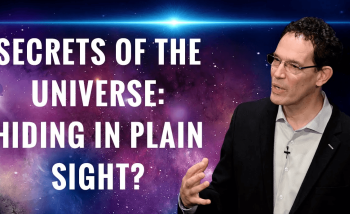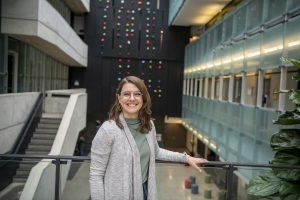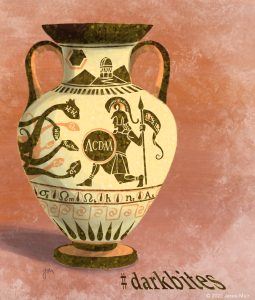Our universe is expanding all the time, faster and faster.
The driving force behind this accelerated expansion is a mystery – and has a suitably mysterious name, dark energy.
Researchers from the international Dark Energy Survey (DES), including Perimeter postdoctoral researcher Jessie Muir, tested numerous models and fundamental questions in search of its explanation.
The simplest model for dark energy is that it could be a cosmological constant: an intrinsic energy that is uniform across time and space. But there are compelling reasons to believe this model is incomplete, so researchers look for inconsistencies between the model and observations – cracks in the facade that may point to a different model.
And they put Albert Einstein’s masterpiece, general relativity, through its paces.
Einstein’s theory of gravity, in the century since he devised it, has exquisitely described the behaviour of planetary orbits, black holes, and other phenomena on cosmic scales.
The team sought to determine whether accelerating expansion is perhaps caused by a fundamental misunderstanding of how gravity works on huge length scales, rather than a new substance contributing to the universe’s energy density.
Maybe, they suggested, Albert Einstein’s theory of gravity – general relativity – is incomplete.
The team’s research, however, vindicates Einstein – at least for now.
Their recent study, based on the first half of the survey’s total 758 nights of observations conducted using the Victor M. Blanco 4-meter Telescope in Chile from 2013 to 2019, is one of the most precise tests yet of Einstein’s relativity on cosmological scales, determined that our current understanding of gravity seems correct. The team recently published their findings in Physical Review D.
The Dark Energy Survey scientists looked for evidence that the strength of gravity has varied throughout the history of the universe. If they found such evidence, it would indicate that Einstein’s theory of relativity is incomplete.
The team used measurements of weak gravitational lensing to determine the ways matter has formed structures over time. With those measurements, the team performed calculations to extract physical information from their galaxy measurements and to test the cosmological constant model.
In addition to testing general relativity, the DES team used that data to probe whether dark energy could be a new field with time-dependent properties, rather than a simple cosmological constant. They also studied the geometry of the universe and questioned whether a fraction of the invisible dark matter that permeates the universe could be made up of a new species of neutrino-like particle.
A "Darkbites" cartoon by researcher Jessie Muir inspired by the team's research: The warrior's shield is labeled Lambda-CDM, referring to the standard cosmological model, and the different hydra heads are labeled to correspond to different cosmological models the team tested.[/caption]
“Testing these models lets us look for mismatches between predictions of the standard model and observations,” explains Muir, who co-led the analysis team behind the paper for the Dark Energy Survey.
“Our hope is that mismatches can provide hints about how to build a more fundamental understanding about big open questions about the universe – like the nature of dark energy.”
The group has now measured the shapes of over 100 million galaxies, some so far away that their light has been travelling to us for 8 billion years – and Einstein’s predictions hold true once again.
“Ultimately, we find that none of the models we test fit the data better than the standard one,” says Muir. “But we are still learning all the time, and all the tools and methods we developed for this study will be useful for even more precise tests with future data.”
Research continues, using ever-more sophisticated techniques and technology, to tease out the identity of dark energy.
The Dark Energy Survey team is hard at work on a final analysis of the survey’s full six-year dataset, and the findings and data-analysis tools they develop will inform the European Space Agency’s Euclid mission, NASA’s Nancy Grace Roman Space Telescope, and the Vera Rubin Observatory LSST.
About PI
Perimeter Institute is the world’s largest research hub devoted to theoretical physics. The independent Institute was founded in 1999 to foster breakthroughs in the fundamental understanding of our universe, from the smallest particles to the entire cosmos. Research at Perimeter is motivated by the understanding that fundamental science advances human knowledge and catalyzes innovation, and that today’s theoretical physics is tomorrow’s technology. Located in the Region of Waterloo, the not-for-profit Institute is a unique public-private endeavour, including the Governments of Ontario and Canada, that enables cutting-edge research, trains the next generation of scientific pioneers, and shares the power of physics through award-winning educational outreach and public engagement.
You might be interested in


Spiralling light from M87’s supermassive black hole reveals strong magnetic fields
November 8, 2023


